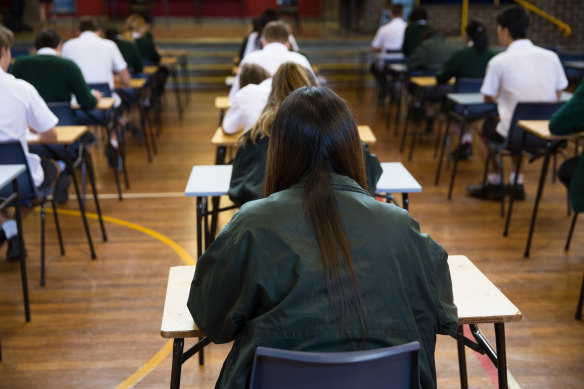
Labor’s plan to offer IB in public schools ‘risks diminishing the HSC’
Principals and education experts warn introducing the International Baccalaureate to the public sector could deepen the education divide, with schools in wealthy areas more likely to offer the costly HSC alternative.
Opposition leader Chris Minns announced on Thursday that under a Labor government public schools would be given the option of running the IB, allowing all school sectors access to the globally recognised qualification.
However, the NSW Department of Education said the plan would incur significant costs – including teacher training and registration – that could run into hundreds of thousands of dollars per school.

A NSW Education Department paper from 2017 said the IB would help attract and retain families of bright students in the public school system.Credit:Janie Barrett
“The Department remains committed to the HSC because it is an inclusive, world-renowned credential that provides [for] all students in NSW,” a spokesperson said.
The IB – which has an emphasis on university preparation – is offered in 37 of the state’s private schools. It is frequently used by schools for marketing purposes and has never been offered in the NSW public system.
An internal Department of Education paper finished in 2017, but never acted upon, recommended state schools offer the IB to give students access to an academically rigorous HSC equivalent.
It would “help attract and retain families of bright students in the public school system”, the proposal said at the time, while estimating it would cost a public school between $44,000 to $300,500 to run the program.
Labor said lifting the restriction would bring NSW into alignment with public schools in Victoria, Queensland, South Australia and the ACT, which all have the option of offering the program to students.
“Individual public schools would be able to lodge expressions of interest to trial the course or courses that suit their school from within their existing budgets,” Shadow Minister for Education Prue Car said.
But Tom Alegounarias, the former chair of NESA, said the HSC has been built and protected by both sides of politics.
“The vast majority of the most outstanding students now do the HSC and that’s what gives the HSC its power.”
Tom Alegounarias, the former chair of NESA
“The HSC is a substantial and glittering asset of NSW. The vast majority of the most outstanding students now do the HSC and that’s what gives the HSC its power,” he said.
“This is crucial for the least advantaged in providing a level playing field and transparent standards and the status of achievement, and no other is as transparent in its standards.
More than 200 schools in Australia offer an IB qualification, including 71 public schools in Victoria, Queensland and South Australia.
Loading
Of the 44 public schools that offer the program and are members of IB Australasia, the vast majority have an above-average ICSEA score, which is a measure of a school’s socio-educational advantage.
Alegounarias said the IB provides independent schools with a point of marketing differentiation, but rolling it out across state schools could “risk diminishing the HSC qualification”.
NSW Secondary Principals’ Council president Craig Petersen said he wanted more detail about the IB proposal amid concerns about how it would be implemented.
“It has implications for resourcing and timetabling. The HSC is highly regarded and provides equitable access to all,” Petersen said.
“We would need to be convinced that any move to IB did not disadvantage students. Many colleagues have already expressed concerns that it would further widen the equity gap between students.”
“It’s been sad that the only way in NSW a student can access IB education was through private school.”
Antony Mayrhofer, Secretary of IB Schools Australasia
However, Dallas McInerney, the chief executive officer of Catholic Schools NSW, said as “a principle of choice” there was a level of demand for the IB, and that should be supported.
“It’s never shown the promise to be a large-scale offering, and the resource intensity is a factor in that,” he said.
Almost 660 NSW students sat IB diploma exams last year, up by about 10 per cent on 2021 enrolments. The number of private school IB students who received an ATAR equivalent score of 99.95 dropped by half after an overhaul of the conversion process that was previously used to give students their university entrance rank.
Loading
Secretary of IB Schools Australasia, Antony Mayrhofer, welcomed the move.
“It’s been sad that the only way in NSW a student can access IB education was through private school, that was not the case in the rest of the country or the rest of the world,” he said.
“It is a very inclusive program, sadly in NSW, it has been seen as being elitist, it is far from that.”
Northern Sydney District Council of P&C Associations president David Hope said more choice for students was important, while Central Coast president Sharryn Brownlee said more funding would be needed to make it successful.
Carol Taylor, a former chief executive of NESA, said while the IB had been considered over a number of years, the HSC is a universal qualification that’s accepted worldwide.
“There is cachet and status involved with the IB. But the HSC is free, equitable and caters for a broad range of students.”
The Morning Edition newsletter is our guide to the day’s most important and interesting stories, analysis and insights. Sign up here.































![iFi's GO Bar Kensei Dongle DAC Supports K2HD Technology With Some Samurai Swagger [Updated] iFi's GO Bar Kensei Dongle DAC Supports K2HD Technology With Some Samurai Swagger [Updated]](https://i0.wp.com/cdn.ecoustics.com/db0/wblob/17BA35E873D594/33FF/45A11/QTXOLJR4xDKSNMMk2WlTgjaIlvSgcYpeU1xJzUwIoYs/ifi-go-bar-kensei.jpg?w=768&ssl=1)

























